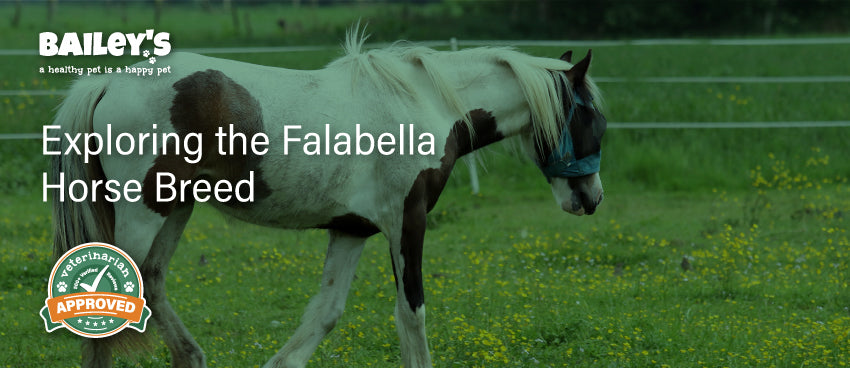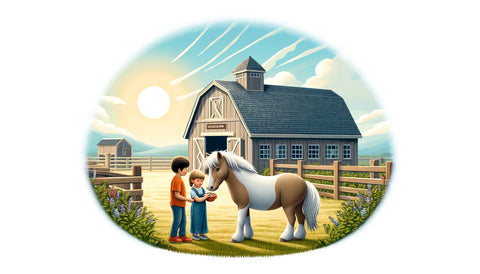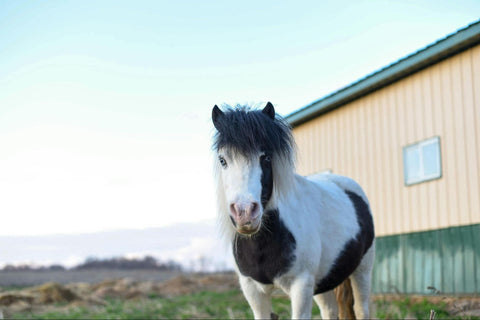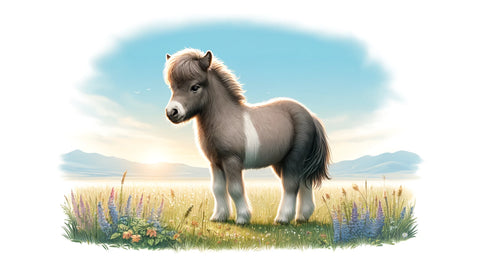Exploring the Falabella Horse Breed

The Falabella horse breed is a fascinating and unique equine that has captivated horse lovers around the world. From its origins in Argentina to its characteristics and modern-day significance, there is much to discover about these magnificent creatures. In this article, we will delve into the history , traits, care, and prospects of the Falabella horse breed.
Table of Contents
Understanding the Origins of the Falabella Horse

The Argentine Roots of the Breed
The Falabella horse breed was first developed in Argentina by the Falabella family, who dedicated themselves to breeding small, refined horses. The foundation of the breed dates back to the 19th century when the family began selectively crossing Thoroughbreds, Shetland ponies, and Criollos. This careful breeding program resulted in a horse that possessed the desirable traits of a small stature combined with elegance and grace.
As the Falabella horses gained popularity in Argentina, they drew the attention of horse enthusiasts worldwide. Their unique characteristics and diminutive size made them a sought-after breed for various purposes, from elegant carriage horses to beloved companions for children. The versatility of the Falabella horse became one of its defining features, showcasing its adaptability and gentle nature.
The Role of Patrick Newtall in Breed Development
Patrick Newtall, an Englishman married into the Falabella family, played a crucial role in further refining and developing the breed. Newtall brought his expertise in breeding and horsemanship to the endeavor, ensuring the breed's continued improvement. Through diligent selection, the Falabella horses began to consistently exhibit their distinctive characteristics, securing their place as a distinct breed.
Newtall's influence extended beyond Argentina, as he shared his knowledge and passion for the Falabella breed with breeders around the world. This global outreach helped solidify the breed's reputation and expand its presence beyond its South American origins. The legacy of Patrick Newtall lives on in the continued appreciation and preservation of the Falabella horse, a testament to his dedication and vision.
Characteristics of the Falabella Horse

Physical Traits and Size
The Falabella horse is known for its petite size and delicate features. Standing at an average height of 7 to 8 hands (28 to 32 inches) at the withers, they are one of the smallest horse breeds in the world. Despite their small stature, Falabellas possess well-proportioned bodies with refined elegance. Their smooth and shiny coats can be found in a variety of colors, including solid colors and pinto patterns.
Temperament and Behavior
Beyond their physical beauty, the Falabella horse breed is celebrated for its gentle and docile temperament. They are known for their intelligence, willingness to please, and adaptability. These traits make them suitable for various equestrian pursuits, including therapy work, driving, and even as beloved family pets. Additionally, their small size and amiable nature make them an excellent choice for children or individuals with limited physical capabilities.
Origin and History
The Falabella horse breed originated in Argentina, specifically in the province of Buenos Aires. The breed was developed by the Falabella family, who dedicated themselves to creating a miniature horse that retained the characteristics and proportions of larger horse breeds. Through selective breeding and careful attention to detail, the Falabellas we know today were created. Their lineage can be traced back to a small group of horses that were bred for their small size and gentle temperament.
Unique Characteristics
In addition to their small size and friendly demeanor, Falabella horses are also known for their longevity. With proper care and attention, these horses can live well into their 30s, sometimes even reaching 40 years of age. This remarkable longevity is a testament to their hardiness and resilience. Despite their diminutive size, Falabellas are known to be hardy and robust, capable of thriving in various climates and environments.

The Falabella Horse in Modern Times
Current Breed Preservation Efforts
As with many rare and endangered breeds, there are dedicated efforts to preserve and protect the Falabella horse breed. Breeders and enthusiasts around the world work tirelessly to maintain the breed's purity and ensure its continued existence. These preservation initiatives include genetic testing, strict registration criteria, and careful breeding practices to uphold the breed's unique qualities.
Efforts to preserve the Falabella horse extend beyond breeding practices. Conservationists also focus on creating awareness about the breed's history and significance. Educational programs, museum exhibitions, and public demonstrations play a crucial role in showcasing Falabella's cultural importance and fostering a deeper appreciation for this remarkable equine breed.
The Falabella Horse in Popular Culture
The Falabella horse has also gained prominence in popular culture, appearing in various forms of media and entertainment. Their exceptional beauty and charming demeanor have captured the attention of filmmakers, photographers, and artists alike. From films to commercials, the Falabella's role in popular culture has further contributed to the breed's recognition and appeal.
Moreover, Falabella's presence in popular culture has inspired a new generation of horse enthusiasts and advocates. Social media platforms, such as Instagram and YouTube, have become hubs for showcasing Falabella's grace and agility, attracting a global audience of admirers. This digital age has not only expanded the reach of the Falabella's influence but has also fostered a sense of community among individuals passionate about preserving and celebrating this extraordinary breed.
Breeding and Care for Falabella Horses
Essential Care Tips for Falabella Horses
Falabella horses, known for their diminutive size and charming demeanor, require specialized care to thrive. Providing a well-balanced diet that meets their unique nutritional needs is crucial for maintaining their health and vitality. These pint-sized equines thrive on high-quality hay, supplemented with a specialized feed formulated for small breeds. Ensuring access to clean water at all times is essential, as even mild dehydration can have serious consequences for these petite creatures.
- Provide a well-balanced diet that meets their nutritional needs.
- Ensure access to clean water at all times.
- Provide regular veterinary care, including vaccinations and deworming.
- Keep their hooves trimmed and provide appropriate hoof care.
- Offer adequate shelter and protection from extreme weather conditions.
- Engage in regular exercise and mental stimulation to promote overall well-being.
Breeding Practices and Considerations
Due to their small size, breeding Falabella horses requires careful planning and consideration. Breeding should only be undertaken by experienced and knowledgeable breeders who understand the challenges associated with their size. It is essential to select suitable mates to preserve the breed's characteristics and maintain genetic diversity. Additionally, responsible breeders prioritize the health and well-being of both the mare and foal throughout the breeding process.
When breeding Falabella horses, it is important to consider not only the physical attributes but also the temperament and personality traits of the potential offspring. This attention to detail helps ensure that the resulting foals possess the desirable qualities that make the Falabella breed so beloved. By carefully selecting breeding pairs and monitoring the process closely, breeders can contribute to the preservation and improvement of this unique and cherished breed.
🌟 Featured Product 🌟

Bailey's Vet-Crafted CBD Pellets For Horses 🐴
Enhance your horse's wellness with Bailey's Vet-Crafted CBD Pellets, designed to support joint health, stress reduction, and overall well-being. Perfect for equine athletes and senior horses to maintain peak condition. 🌱
Learn More & Purchase Here ➡️The Future of the Falabella Horse Breed

Conservation Status and Threats
While the Falabella horse breed is not currently classified as endangered, its population remains relatively small. The dedication of breeders to preserving and promoting the breed is crucial for its long-term survival. External threats such as loss of habitat, disease, and lack of awareness about the breed pose ongoing challenges. However, through continued efforts and proactive conservation measures, it is possible to secure a bright future for the Falabella horse breed.
Potential Developments in Breeding and Care
The future of the Falabella horse breed holds promise for further advancements in breeding techniques and enhanced care practices. Emerging technologies, such as genetic testing and assisted reproductive techniques, offer possibilities for maintaining genetic diversity and improving overall breed health. Ongoing research and collaboration among breeders and scientists will undoubtedly contribute to the sustainability and growth of this remarkable breed.
Exploring the History and Origins of the Falabella Horse
To truly understand the future of the Falabella horse breed, it is essential to delve into its rich history and origins. The breed traces its roots back to the Pampas region of Argentina, where it was developed by the Falabella family in the mid-19th century. The Falabellas dedicated themselves to creating a miniature horse breed that possessed all the grace and elegance of its larger counterparts.
Over the years, the Falabella horse breed gained recognition for its unique characteristics, including its small size, refined features, and gentle nature. These traits made it a favorite among royalty and aristocracy, who sought to own these exquisite creatures as symbols of prestige and beauty.
Preserving the Legacy of the Falabella Horse
As we look to the future, it is crucial to acknowledge the importance of preserving the legacy of the Falabella horse breed. While its small population size may be a cause for concern, the dedication of breeders and enthusiasts worldwide ensures that the breed's unique qualities will continue to thrive.
Efforts are being made to raise awareness about the Falabella horse breed, educating the public about its history, characteristics, and the need for its conservation. Through educational programs, exhibitions, and events, more people are becoming familiar with this remarkable breed, fostering a greater appreciation for its beauty and significance.
Conclusion
The Falabella horse breed is a treasure that combines history, beauty, and versatility. With its origins rooted in Argentina, the breed has evolved to become a symbol of elegance and charm. From its distinct physical traits to its gentle temperament, the Falabella horse captivates all who encounter it.
However, the breed faces ongoing challenges that necessitate proactive preservation and responsible breeding practices. By working together to protect and promote the Falabella horse, we can ensure that future generations continue to appreciate and marvel at these majestic creatures. Through continued research, collaboration, and dedication, the future of the Falabella horse breed shines bright with possibilities.











